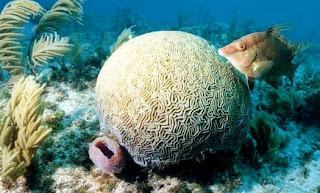Centuries-old Florida coral reef was massacred during 2010 cold snap

KeysNet reports: The corals of the Florida Keys which took centuries to grow died within days during the frigid January 2010 cold snap, says a newly published scientific study.
"Some monumental corals that were 200 or 300 years old perished in a span of five days," said Rob Ruzicka, a co-author with Michael Colella of the patch-reef study published in the February edition of Coral Reefs, the journal of the International Society for Reef Studies.
Colella and Ruzicka work for the Fish and Wildlife Research Institute of the Florida Fish and Wildlife Conservation Commission, and have been involved with the 17-year history of the institute's Coral Reef Evaluation and Monitoring Project.
The published cold-water study focuses on patch reefs, generally found in depths of 12 to 20 feet in Hawk Channel, inside the main Florida Keys coral reef, that did not suffer damage as severe.
Some of the patch reefs lost from half to two-thirds of their coral cover as a result of the cold-water bleaching. "They basically died of hypothermia," Ruzicka said.
Most of the stony corals on the patch reefs killed in 2010 go by the common names boulder star, massive starlet, brain and mustard.
"These were corals that had not changed significantly in years and were doing relatively well," Ruzicka said. "They survived other cold-water events that killed coral, but not this one."
During the worst of the 12-day cold spell, monitored water temperatures at the patch reefs dropped to as low as 52 degrees. More significantly, water temperatures stayed below 61 degrees for just short of two weeks.
"Although cold-water [caused] mortalities have been described before, the record-breaking weather of January 2010 and concordant mortality at formerly healthy patch reefs suggest that this event was one of the most severe in the last century," says the study, which lists FWC researchers J.A. Kidney, J.M. Morrison and V.B. Brinkhuis as co-authors.
Diving surveys for the study focused on Burr Patch in the Upper Keys and Dustan Rocks, Thor Patch, and West Turtle Shoal in the Middle Keys.
Lower Keys patch reefs generally were not as damaged, likely because of greater depths and less extremely cold water from Florida Bay flowing into the Atlantic Ocean, Ruzicka said.
As for the others, "We heard some anecdotal accounts from our colleagues in the Keys," said Ruzicka, based in St. Petersburg. "But when we got down there, we were astounded by what we found. The effects were visible and stark. You could take a finger and run it down the side of the coral and see tissue falling off the skeleton. It was a tragic event."
Cold-water bleaching usually proves deadlier to corals than the more common warm-water bleaching.
Some new corals have recruited to the damaged sites, but recovery is a long-term process, Ruzicka said.
"It could be decades if not centuries," he said. "And the corals need long-term stability, without significant animal predation or another major stressor event."
Findings from the study will help researchers track recovery rates and help to differentiate between natural mortality events and man-made damage.
"We may never know for sure if other stressors, like water quality, pushed the corals over the edge this time, Ruzicka said. "There is no doubt this is one of the worst incidents on record."



Comments